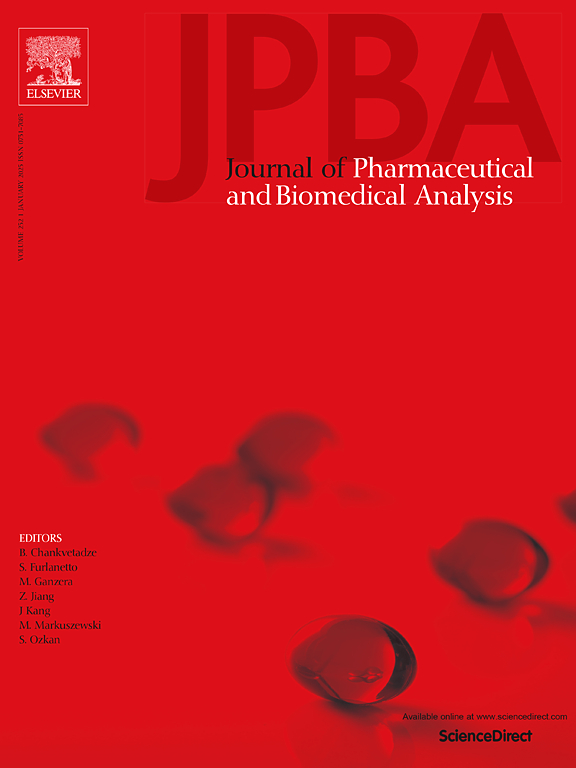Therapeutic glycoprotein hormones: Considerations for the use of in vitro alternatives to in vivo potency assays
IF 3.1
3区 医学
Q2 CHEMISTRY, ANALYTICAL
Journal of pharmaceutical and biomedical analysis
Pub Date : 2025-04-10
DOI:10.1016/j.jpba.2025.116895
引用次数: 0
Abstract
Therapeutic protein hormones such as Erythropoietin and Gonadotrophins have historically utilised in vivo bioassays for potency assignment. In line with 3 R’s principles for animal research, manufacturers and regulatory authorities alike are continually seeking to implement in vitro alternatives to animal assays wherever possible. However, these proteins are heavily glycosylated, giving rise to an inverse correlation of in vivo and in vitro biological activities, which complicates the transition away from in vivo bioassays for potency assignment. Whilst manufacturers are actively pursuing the development of alternatives to in vivo bioassays for product quality control, these efforts inevitably result in product-specific approaches, which are unlikely to be representative of all versions of the same product from different manufacturers. This presents a further challenge for organisations tasked with ensuring harmonisation of dosage between products from different manufacturers, through provision of documentary (pharmacopoeial monographs) and physical (assay calibrators) standards, as such resources must be suitable for all licensed versions of a product. This review will describe these challenges, and the product-specific approaches which have been implemented by manufacturers, and propose a framework aimed at mitigating the risks associated with the wider introduction of in vitro alternatives to in vivo potency assays.
治疗性糖蛋白激素:使用体外替代体内效价测定的考虑
治疗性蛋白激素,如促红细胞生成素和促性腺激素,历来使用体内生物测定法进行效价分配。根据3 R的动物研究原则,制造商和监管机构都在尽可能地寻求实施体外替代动物试验。然而,这些蛋白质严重糖基化,导致体内和体外生物活性呈负相关,这使得从体内生物测定到效价分配的转变变得复杂。虽然制造商正在积极寻求替代体内生物测定法来控制产品质量,但这些努力不可避免地导致产品特定的方法,这些方法不太可能代表来自不同制造商的同一产品的所有版本。这对负责通过提供文件(药典专论)和物理(测定校准器)标准来确保不同制造商产品之间剂量一致性的组织提出了进一步的挑战,因为这些资源必须适用于产品的所有许可版本。本综述将描述这些挑战,以及制造商已经实施的针对特定产品的方法,并提出一个框架,旨在减轻与更广泛地引入体外替代体内效价测定相关的风险。
本文章由计算机程序翻译,如有差异,请以英文原文为准。
求助全文
约1分钟内获得全文
求助全文
来源期刊
CiteScore
6.70
自引率
5.90%
发文量
588
审稿时长
37 days
期刊介绍:
This journal is an international medium directed towards the needs of academic, clinical, government and industrial analysis by publishing original research reports and critical reviews on pharmaceutical and biomedical analysis. It covers the interdisciplinary aspects of analysis in the pharmaceutical, biomedical and clinical sciences, including developments in analytical methodology, instrumentation, computation and interpretation. Submissions on novel applications focusing on drug purity and stability studies, pharmacokinetics, therapeutic monitoring, metabolic profiling; drug-related aspects of analytical biochemistry and forensic toxicology; quality assurance in the pharmaceutical industry are also welcome.
Studies from areas of well established and poorly selective methods, such as UV-VIS spectrophotometry (including derivative and multi-wavelength measurements), basic electroanalytical (potentiometric, polarographic and voltammetric) methods, fluorimetry, flow-injection analysis, etc. are accepted for publication in exceptional cases only, if a unique and substantial advantage over presently known systems is demonstrated. The same applies to the assay of simple drug formulations by any kind of methods and the determination of drugs in biological samples based merely on spiked samples. Drug purity/stability studies should contain information on the structure elucidation of the impurities/degradants.

 求助内容:
求助内容: 应助结果提醒方式:
应助结果提醒方式:


